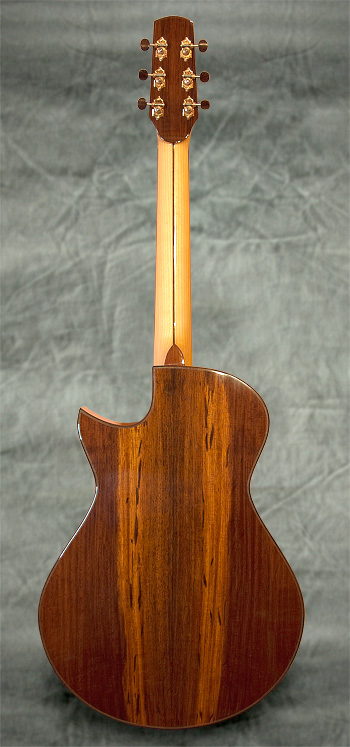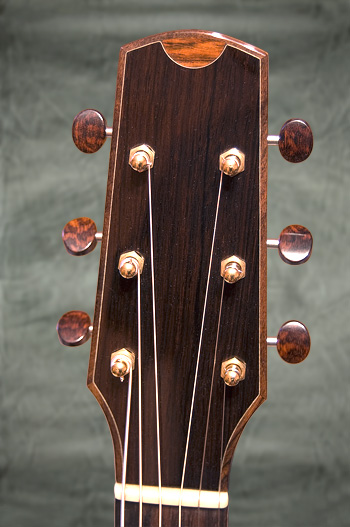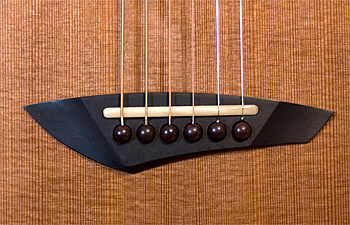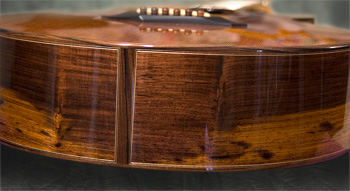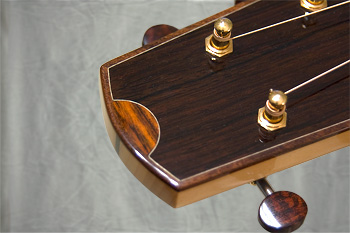2009 Bashkin 00 12-fret
(click on images to see larger versions)
– top: LS redwood (Sequoia sempervirens); the Carter’s famous Lucky Strike log
– back: Panamanian rosewood (Dalbergia tucarensis).
– sides: inner side: Bolivian rosewood (Machaerium spp.); outer side: Panamanian rosewood (Dalbergia tucarensis).
– neck: 3-piece Port Orford cedar (Chamaecyparis lawsoniana) and Bolivian rosewood; adjustable truss rod
– fingerboard: 50 yr. old Brazilian rosewood (Dalbergia nigra) gunstock blank
– bridge: ebony
– bridgepins: snakewood
– front headplate: Brazilian rosewood salvaged from a 60’s Guild, w/ Panamanian rosewood half-moon insert
– back headplate: Madagascar rosewood
– body bindings & endgraft: Bolivian rosewood with maple veneers
– heelcap: Bolivian rosewood
– nut & saddle: West African Hard Ivory
– tuners: gold-plated Waverlys w/ snakewood buttons
– bridgeplate: Honduran rosewood
– rosette: bone, torched myrtlewood and koa
– side fret markers: mother of pearl
– fret markers: mastodon ivory
– kerfed lining: Spanish cedar
– neck- & tailblocks: mahogany w/ a Brazilian rosewood cap on the neckblock
– top braces: Adirondack spruce
– back braces: Sitka spruce with Bolivian rosewood cap on the X.
– glue: hide glue
– finish: UV polyester
– top bracing: modified X-brace with an element of fan bracing (see photo). The finger braces are also half-lapped onto an asymmetrical bridge plate of Michael’s design
DIMENSIONS:
scale length: 25.4″
nut width: 1 25/32″ (1.78″)
string spacing at saddle: 2.25″
weight: 4.2 lbs.
width, upper bout: 10.3″
width, lower bout: 14.25″
depth at neckblock: 3.5
depth at tailblock: 4.15
body length: 19.65″
total length: 39.2″
A Player’s Review, 7/20/09:
In evaluating this guitar, I also used my 2007 Circa OM for contrast. The Circa, being an instrument that I know well, was meant to serve simply as a baseline guitar to illuminate their differences, and not a standard against which the 00 was to be measured. I put a set of new Curt Mangan medium-light strings on both my Circa and the 00 and played both of them by turns for several hours. The scale length and neck dimensions were the same, but otherwise, given the fact that the woods, body size, bracing, and overall design were so different, a head-to-head comparison was neither possible nor desirable. Indeed, it was the differences between them that I was most interested in. The Circa was built to be a new expression of the ‘Vintage’ sound with strong fundamentals, and a punchy focused voice, while the Bashkin is an example of the ‘Contemporary’ sound with a more responsive, ringing quality and greater complexity in the overtones. After I got a feel for their differences in this initial session, I put the Circa aside to evaluate the 00 on its own terms. I continued to experiment with different brands of string and different string gauges for the next several days. During this period, when I occasionally picked up the Circa again for contrast, I was interested to find that, while the Circa had its strengths, there were some aspects of it that now suffered in comparison to the 00.
Michael Bashkin has been building guitars full-time since 1998 and studied with noted luthiers Harry Fleischman and Ervin Somogyi. When I went looking for a superb example of the Contemporary sound, I started with the luthier lists from the Healdsburg, Montreal and Newport Guitar festivals, and began researching their websites. Bashkin guitars, with their elegant and distinctive design, appealed to me immediately, and after I got the opportunity to play one, and got to know Michael, I felt confident that he could build the kind of guitar that I would appreciate. One gets the impression that he doesn’t follow usual building techniques just as a matter of course, but has carefully considered every feature of a guitar’s design and construction and made conscious choices about all aspects of his approach. I’ve found him to be a deeply thoughtful and creative luthier, quietly driven to produce distinctive instruments that can stand among the finest guitars in the world.
Over a period of eighteen months, Michael and I went through extensive talks using several of his guitars and my Circa for reference, in order to clearly define the sound I was looking for in a Bashkin. I also told him that I favor light guitars. The only things I specified other than the target sound were a cutaway and a neck profile exactly like my Circa. John Slobod kindly sent Michael one of his necks to use as a template, and all other decisions regarding body size, woods, etc. were left to the builder.
Playing a guitar is a complex sensory experience involving Sight, Sound and Touch, and here are my thoughts regarding each of these dimensions for this guitar.
SIGHT
Bashkin’s background in environmental science and his love of Japanese art express themselves clearly in the clean lines and celebration of rare and beautiful woods that make up the Bashkin design aesthetic. In this instrument, featuring five different types of rosewood and eleven(!) other exotic woods, Michael has produced one of the most distinctive guitars I’ve ever seen. Nearly every feature of this guitar is visually dramatic and arresting, and the more one looks, the more there is to notice. The label lists the number ‘9309,’ signifying that this is Bashkin Guitar # 93, completed in 2009.
Michael’s interpretation of the 00 body shape is slender and fluid. The LS redwood top (for more info on this rare and remarkable wood, see post #40 on page 3 of this thread), is richly colored with greater contrast in the grain than cedar, with a lot of detail to draw the eye that is not as obvious in spruce. The bone/torched wood rosette, bridge shape and headstock are signature Bashkin features with a distinctive design. The Panamanian rosewood back and sides look unlike any other wood I’ve seen, with its colors ranging from chocolate to golden, and contrasting dark flecks throughout. Bashkin guitars feature a stiffer, double-sided construction to more efficiently focus the strings’ energy to the top, and the inner sides are Bolivian rosewood. The fingerboard, from a 50 yr. old Brazilian rosewood gunstock blank, has dark red and brown grain running at a slight angle to the centerline adding visual interest to a feature that typically has the uniformity of black ebony. The instrument will eventually have 3 mm mastodon ivory fingerboard fret markers (not shown in photos) at the 5, 7, 9, 12 and 15 frets. The wood chosen for the rosette materials, purfling, binding, bridge pins, tuner buttons, headplates and heel cap seem to complement each other and integrate well with the overall red/gold/brown color scheme. The cream-colored Port Orford cedar neck, chosen over mahogany for its lighter weight, looked, during the build process, to be somewhat incongruous with the rest of the woods, but in the finished instrument provides a bold contrast that I’ve come to appreciate, setting off the darker front and back headplates, with the dark Bolivian rosewood accent strip in the center linking it back to the rest of the guitar’s colors. Looking inside, the guitar is very clean, though there is some very slight squeeze-out of the hide glue visible along the back braces which might trouble the exceedingly fastidious.
TOUCH
Most of this category addresses how it feels to play it, but there are some basic tactile impressions as well.
At 4.2 lbs. the overall weight is fairly light, and the balance point when held in playing position is perfectly situated, just over the upper bout. The neck profile was shaped to match that of my Circa, and I discern very little difference between the two. There are some guitarists I know who prefer the feel of lacquer to the UV poly finish, but I think it feels fine, and I appreciate the increased protection from the harder finish.
As to playability, the action as currently set up feels smooth and very easy to play, though there’s a bit of buzzing when driven hard, especially with a capo on. Michael builds his necks with a bit flatter relief on the treble side than the bass side, and digging in at the 4th or 5th fret creates a slight buzzing I don’t hear at the 2nd fret or on an open string, so the neck relief on the treble side might need some small adjustment, or perhaps the whole action might need to be raised slightly for firm strumming. I try to play with a light touch and seldom get string buzz, so the current action is fine for most of my playing purposes.
The Circa and 00 have exactly the same fret scale and are equipped with exactly the same strings at the same tension, yet the 00 feels noticeably easier to play. It could have something to do with the lower neck relief on the treble side, but this apparent tightness or looseness in playability between guitars under identical string tension is a phenomenon widely noted by others. Luthier Howard Klepper has suggested that greater flexion and response in the tops and necks of some guitars make them feel looser than others, and this seems sensible to me. Perhaps the redwood and Port Orford cedar in the 00 flexes more than the Adirondack spruce and mahogany in the Circa. The increased flexion might also have something to do with the Bashkin top’s modified X-brace with fanned finger braces half-lapped onto the bridge plate.
SOUND
Balance. The first quality I listen for, the make-or-break feature that determines whether I maintain an interest in the guitar or say “Oh, well” and move on, is balance, and with the possible exception of the SJ (Small Jumbo) I played last year, this 00 is the best balanced Bashkin I’ve played so far. Strong midrange and trebles are a characteristic of the Bashkin sound, and though I’d still prefer slightly more depth in the low E, it certainly has good presence, and I have no trouble picking it out within a strummed chord. I freely admit my tastes in this regard may be idiosyncratic. Al Petteway played this guitar and declared its balance to be ‘perfect,’ and Circa’s John Slobod thinks the bass response of the Bashkin sound to be one of its strongest features.
Sustain. I measure sustain by using a stopwatch, hitting a firm strum, then leaning in close until the sound fades to silence. I do this 4 or 5 times, then average the times. I’m usually within a second each time. My 1980 Sobell cittern is my benchmark instrument for a long sustain at 42 seconds. The Bashkin’s sustain is around 30-35 seconds, and fairly long for a guitar, I think. The fundamental tones have the longest decay, with the harmonic partials falling away after 15-20 seconds or so.
Volume. I’d characterize the volume as very good. It’s not quite as loud as the Circa, but still a surprisingly big voice for an instrument its size. The volume might benefit from medium strings. It achieves a forceful presence fairly easily, without a tremendous amount of headroom, but on the other hand, it’s very articulate at low volumes, which makes it extremely sensitive to a light touch.
Response. This guitar’s response is exceptionally lively and one of its greatest strengths. I’ve always thought of my Circa in rather regal terms, and I approach playing it with a certain amount of respect and focus to get it to sound its best. The 00, on the other hand, is much more intimate and approachable, and seems almost eager to sing under the lightest touch. I think the ergonomics of its smaller size also contributes to this feeling of intimacy.
Depth. The depth or spaciousness of the sound is what gives it dimension and presence. I think of it as how far down in the guitar the sound seems to come from and how completely the sound chamber is pushing out sound. The 00 seems to have very good depth for its size, with a presence I would expect from a larger instrument. It’s a full, throaty voice for a little box.
Resonance. The number and character of harmonic frequencies detectable in the sound is what many call resonance. However, I make a distinction for it here as a measure of fullness in the sound I can both hear AND feel. With a fairly light weight, this guitar seems to vibrate very freely. Once strings are struck to set the top in motion, the whole instrument seems to resonate completely in a way that can be heard as well as felt through the hands, chest and abdomen. While others played the guitar, I placed a finger on the end of the headstock, and different places on the sides, neck, and back. As one would expect with a double-sided construction, the sides were relatively inert, but everywhere else the guitar was vibrating freely.
Overtones. Overtones are the harmonic frequencies complementing the fundamental tones. Some limit the definition to partials of the plucked strings, but I use it to encompass sympathetic vibrations in the unplucked strings as well. As luthier Alan Carruth puts it, “An acoustic guitar acts as a complex filter, reducing the output of some frequencies and enhancing others relative to the mix the plucked string produces. Every guitar is a bit different in this regard.” An instrument that generates a lot of overtones is said to be ‘complex’ or ‘sparkling,’ while one with fewer overtones is said to be ‘dry.’ These complementary frequencies add tonal color, giving the sound ‘personality’ and are one of the hallmarks of the Contemporary sound. This was an area in which I was looking for something decidedly different from my Circa. The Bashkin achieves this in ways that are really quite remarkable, combining subtle, ringing tones over robust fundamentals (a quality I call ‘shimmer’) with a woody warmth. It’s an impressive feat, and I would expect a guitar with this much shimmer to be brighter, with less warmth. When strummed, the strings blend beautifully, producing a nice, even shimmer across the chord. The trebles, especially, have a compelling, chime-y quality to them that make my Circa’s trebles seem a bit sterile by comparison.
Timbre/Tone. If the overtones give the sound ‘personality,’ timbre describes the quality of that personality, combining the fundamentals, overtones and all other resonant frequencies generated by both the vibrating strings and the vibrating wood to create a particular instrument’s unique voice. It’s what makes a middle ‘C’ played on a clarinet sound different from a middle ‘C’ played on a trumpet. It’s this ‘quality of personality’ I believe most folks refer to when they speak generally about a guitar’s ‘tone,’ and this is a subjective area I find difficult to discuss at all without the heavy use of metaphor, such as its “eagerness to sing” mentioned above. The combination of warmth and shimmer in this instrument creates a distinctive timbre marked by a sweetness that invites the listener to relax and be enveloped. Others who have played it have described this guitar as combining some of the lushness of cedar with the sparkle of spruce. Although its voice is rich and assertive, there is also a delicacy to it, and when played with a light touch, the timbre is really quite intoxicating. I plan to replace the bone nut & saddle and perhaps the pins with West African hard ivory to give a slight boost to the guitar’s clarity and presence.
SUMMARY
What I’m always looking for are guitars I would consider ‘Exceptional;’ among the very best of the best. I admit I’m exceedingly difficult to please, and I find such guitars to be, as the name implies, exceptionally rare. So is this an Exceptional guitar? I’m extremely hesitant to award any instrument that status, and this guitar is still very new, but I certainly do find it to be extraordinary in many ways, and I’m eager to see how it develops over time, and what little tweaks in the strings, nut, pins and saddle might do for a sound that I already find to be uniquely beautiful.
This guitar was not built ‘for’ me, but ‘with me in mind,’ and was sent to me simply for my feedback and review. As picky as I am, perhaps the highest praise I can give it is that I decided to keep it.
UPDATE – 8/31/09:
I recently replaced the vintage bone nut & saddle with those made of West African Hard Ivory, and spent several hours swapping out the two saddles, listening for the difference. In addition, since the guitar’s playability was already ‘loose,’ requiring little effort to finger, I also tried going from lights to D’Addario medium strings. With the combination of these two changes, I think I’ve found this guitar’s ‘sweet spot,’ making the sound even more remarkable. Presence, depth, resonance and volume have all increased noticeably, and the timbre has acquired a more solid quality, reminiscent of my regal Circa. The overtones of the mediums over the bone saddle seemed a bit dry, but once I put the ivory saddle in, the sparkle and shimmer returned. Without sacrificing sweetness, the timbre is now bolder, less delicate, while the heavier strings, vibrating in a tighter arc, help me to play cleaner while still being as easy to finger as my eminently playable Circa. I’m eager to see how time and use might improve it further.
UPDATE – 5/19/16:
A few years after I acquired the Bashkin, after continual gentle whining to Michael that I wish it had more depth on the low end, Michael offered to work on the bracing to see if he could get closer to the sound I wanted. When he returned it to me, the change in depth was transformative, and what I had hoped for. The reworked bracing affected the entire dynamic range, so we found that two treatments hit the sweet spot and gave just the right balance of added depth in the low end without sacrificing much of the assertiveness of the high end. Ever since, in every playing situation requiring fingerstyle, the Bashkin has become my default instrument, and I can now say that not only do I consider it to be of ‘Exceptional’ status, but it has become the finest sit-on-the-couch-and-fingerpick guitar I’ve ever owned and as close to perfect for that purpose as I could hope for.
UPDATE – 9/19/22:
The enhancements Michael made to boost the low end, while significant, eventually made me restless for more. I still felt the guitar had more to give than what I was hearing. The low end had improved, but it wasn’t quite there yet and I found myself neglecting it. I have a ‘no play, no stay’ rule, so I called Michael and told him I was considering selling it. He urged me not to give up on it, but to send it back to him because he’d learned more about modifying the tonal qualities of existing guitars and he wanted to try some things, including stripping the UV finish from the top and applying a french polish. So I shipped it back to him and told him to take his time on it and work it into his build schedule when he could.
After the better part of a year, he sent it back, with newly revoiced bracing, a new Brazilian rosewood bridge and a new, french polished top. When I played it again, the improvement was so dramatic I almost didn’t recognize it. His earlier tweaks made it sound like an improved version of itself, but this time it almost sounded like a completely different guitar, with such an extraordinary tonal balance that, even among my other Exceptional guitars it stands out. I play it all he time now, and it’s in no danger of ever leaving my collection.


